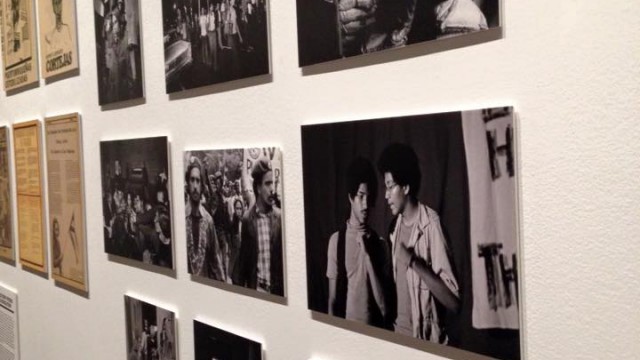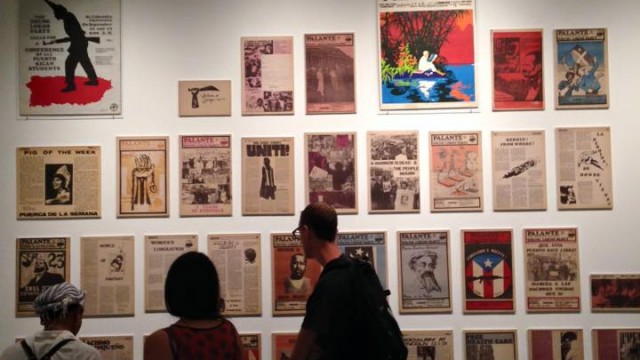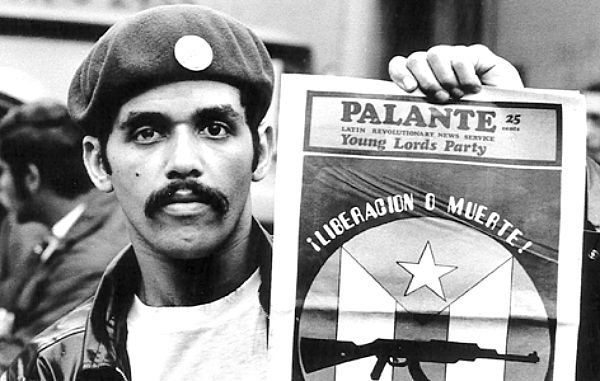by Liam Fox
¡Presente! The Young Lords in New York was on display at The Bronx, El Museo del Barrio and Loisaida museums in New York this fall. The exhibit displayed the immense body of art, culture, and politics that the Young Lords produced over the years, a sort of shrine to the radical love that the movement was so committed to.
The Young Lords Party (YLP) was a group of mainly Puerto Rican socialist revolutionaries who organized in cities across America during the 1960s-80s. The party was influenced by groups such as the Black Panther Party. YLP gradually transformed itself from a small network of gang members into a broader human rights movement pushing neighbourhood empowerment and Puerto Rican self-determination as its core missions.
Lining the walls of the Bronx Museum in particular are dozens of copies of Palante, The Young Lord, and Pitirre , the three newspapers produced by the party. These newspapers recounted the stories and culture that gave life to the Young Lords movement, and it is for this reason that the newspapers are still admired and displayed in museums to this day.
The newspapers documented the atrocities committed against these racialized working class groups over the years—violent racism, poor housing conditions, police brutality, and even a CIA undercover program to flood Puerto Rican neighbourhoods with heroin.
Countless other historical examples can be drawn of newspapers acting as a central means of uniting people by documenting struggle—notably, the Black Panther Party paper, which outlined the famous 10-point program calling for ‘Land, Bread, Housing, Education, Clothing, Justice, and Peace’ among other demands. Another is the Detroit Revolutionary Union Movement newspaper, Inner City Voice , that was not only the voice of radical politics in working class black Detroit but also published articles on guerrilla movements in Latin America, women’s liberation, and anti-war movements during the 1960s. The titles of the headlines in this paper make it clear the ideological agenda it promoted: “Michigan Slavery”, “Cops on rampage- 14 year old shot”, or “Black worker uprising”, to name but a few. The newspaper here was used as not only as a tool for education and empowerment, but also to counter the hegemonic discourse of capitalist publications that were all but silent on the substantive issues of class, race, or gender.

The culture of revolution: Documenting and archiving the Young Lords struggle in New York circa 1970
While the newspaper can be a tool used for social change, if in the hands of the wrong people it can also be a tool used to control people. The bourgeois mass media—most large-scale television, radio, and newspapers that are run to make a profit—don’t tell the stories that reflect people’s struggles. Rather, they skew and distort stories to make them more palatable, pleasant, and less ‘threatening’ to the social order. This is because the mass media is controlled by people who have a vested interest in the status quo, and whose profit or dominance is threatened by the idea of large-scale social change–that is, they are capitalist enterprises.
Stories that are run by the bourgeois media claim to take a ‘neutral’ stance, but in truth they are pushing a very carefully constructed, de-politicized point of view. They could not, for example, publish an article pushing a specific anti-capitalist, anti-racist, or anti-colonial perspective.
Even the best left-wing journalist enterprises are most often bourgeois media, and because of this their stories are limited in scope and purpose. The Toronto Star is an excellent example of this. The Star can run an editorial on the ongoing genocide of Palestinians by the settler colony Israel but at the same time endorse Liberal leader Justin Trudeau for Prime Minister–a man who is a professed Zionist and apologist for Israeli apartheid.
Likewise, right-wing publications in Toronto appeal outright to populism with no attempt at critical commentary. The Toronto Sun, for example, has strong ties to capitalist think-tanks (the Fraser Institute, C.D. Howe Institute, or Conference Board of Canada to name a few) that are funded by corporations or political interests with deep pockets.
The community newspaper, then, has a duty to expose these faults in the mass media, to poke holes in its ideology at every opportunity, and to document instead the stories that reflect the experiences of the working class.

Archived front pages of Young Lords newspapers on display at the Bronx Museum, New York
It is newspapers like those produced by the Young Lords that recount the story of revolution and a creative imagination of another world that is possible. More than that, it reminds us of the need to document and archive struggle. In many ways this same documenting and archiving drives hip hop’s need to preserve the history and legacies of slavery and racism in America, and other artistic representations of suffering and loss. And, because the newspaper is mass-distributed, it is a useful tool for uniting many of us in a common struggle—to bring people together by documenting the livelihoods, stories, and collective memory of exploitation endured by working-class people.
Archives of Palante can be found online here .
Radio Basics interviewed the Young Lords founder José Cha Cha Jiménez, archived here .
Comments

Pingback: Cross-post: ¡Liberación O Muerte! Why People’s Journalism Matters | Liam Fox